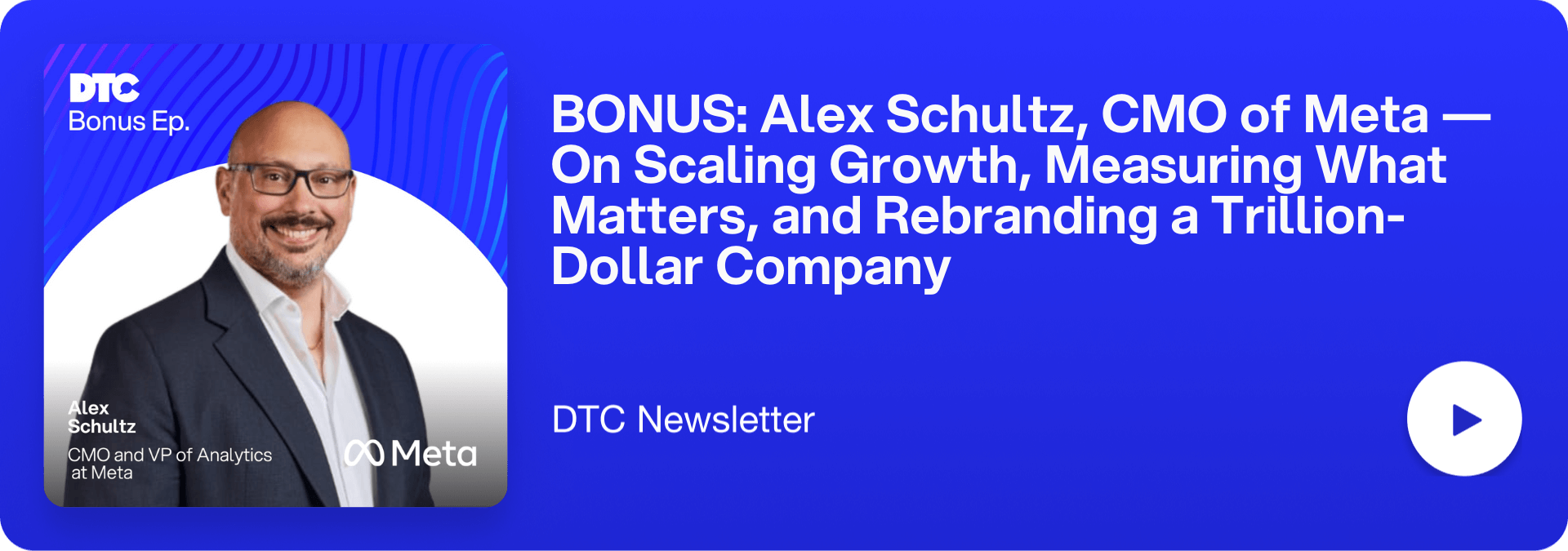
Back

Content
Content

Welcome to the DTC family!
Oops! Something went wrong while submitting the form.

Back

Content



Good morning,
Here’s what you’ll find in today’s DTC:
💰 Rebranding a Trillion Dollar Company
Diving into Meta’s modern growth playbook.
⚡ Amazon Ends A Controversial Practice
What phasing out commingling means for brands.
📐 Develop Effective Ad Angles
Stress-test angles using this proven framework.
💡 Build Better Landing Pages
Why making this one change unlocks conversions.
You’re reading this newsletter along with new subscribers from: Cove Soda, Kermit Chair, and Empire Homes. 👋

🚨 ROAS ≠ Business Performance. PopSockets, Tushy, and Plunge Already Know It
The dashboards are green. ROAS is spiking. 🎉
Then the CFO asks: “Cool… so why is revenue flat?”
That’s when the truth hits: you can hit every ROAS target and still miss the company's goals.
Why? Because attribution takes credit for sales that would’ve happened anyway.
👉 The gap between “ad platform success” and “business success” is where Stella lives.
With Stella’s incrementality testing and MMM, you finally see:
That’s the story that protects your budget.
PopSockets, Tushy, and Plunge already use Stella to prove real incremental lift.
🔑 Try Stella free for 7 days. No credit card required.
* sponsored

🎧 Alex Schultz, CMO of Meta on Scaling Growth, Measuring What Matters, and Rebranding A Trillion-Dollar Company
In this episode of the DTC Podcast, we sit down with Alex Schultz, the CMO and VP of Analytics at Meta, to unpack nearly two decades of marketing insights from inside one of the most influential tech companies on the planet.
From his scrappy beginnings as an affiliate marketer trying to pay for college, Alex rose through the ranks at Facebook, helping launch self-serve ads, custom audiences, and building the company’s analytics function from the ground up.
Now, as CMO, he shares how he thinks about brand vs. performance, why incrementality measurement is non-negotiable, and what it really took to lead the rebrand from Facebook to Meta in under seven months.
In this episode, you’ll hear: 👇
No matter where you are in your marketing journey, this is an episode you don’t want to miss.
👉 Listen to the full episode with Alex Schultz here.

💰 The End is Here: Amazon Ends Commingled Inventory
Amazon just announced it’s retiring its commingled inventory system, a move that signals a big win for brand control and integrity.
What’s commingling?
Previously, Amazon pooled identical products from multiple sellers into one bin. When a customer ordered, Amazon shipped the nearest unit, regardless of which seller supplied it.
While this sped up fulfillment, it also opened the door to counterfeit or expired goods being mixed in with authentic products, making quality issues nearly impossible to trace.
For brands, especially those with multiple distribution channels, commingling created serious risks: counterfeit complaints, poor customer experiences, and liability for products they didn’t even sell.
Why the change?
Amazon cites two main reasons: improvements in its logistics network and the fact that most sellers today are brand owners, not resellers.
This shift reflects Amazon’s growing support for protecting brands over gray-market resellers.
What this means for you:
Pilothouse has seen firsthand the damage commingled inventory can cause.
This update is a huge step forward for brand owners on Amazon, but it also means sellers need strong operational strategies to fully capitalize on the shift.

🌟 Over 75% of Consumers Check This Before They Buy From You
👉 More than 75% of consumers check the reviews before buying a product, and this number spikes even higher around BFCM as shoppers make purchasing decisions.
Reviews are a vital tool to boost conversions, but how do you get high-quality reviews for new seasonal products and holiday bundles when the clock is ticking? ⏰
🔑 Gifted reviews are the key, and Skeepers’ new ebook is your guide, giving you the three essential elements to a successful BFCM campaign.
It reveals how to incorporate the power of UGC and gifted reviews into your strategy and leverage reviews into long-term insights and SEO boosts long after BFCM ends. 📈
With over 75% of shoppers looking for them, make sure those holiday SKUs have reviews. ⭐️
* sponsored

🎧 The Try-Angle Method for Smarter Ads
On this episode of Ad-venturous, Aves breaks down one of the most overlooked but powerful tools in performance marketing: ad angles.
Too many DTC brands grow to mid-seven figures on aesthetics and vibes alone, only to stall when they lack durable, persona-driven angles that work across channels and funnels.
In Avery’s words:
👉 An angle = how you position your product to attract a customer.
It can be driven by one of two things:
Both matter. But the key is aligning the angle with personas and funnels.
👉 Listen to the full episode with Aves here.

Cramming multiple benefits or pain points on a landing page confuses visitors and reduces conversions.
Instead, each section should focus on a single, distinct benefit or objection, using testimonials, reviews, or UGC to reinforce it.
Strategically layering these benefits guides visitors along a clear path and turns your page into a high-converting machine.


🤫 Walmart’s latest New-Seller Savings is too huge to miss. Be sure to take advantage of this unprecedented offer and the endless opportunities on Walmart.com. *Conditions apply. Sign up here. *
* sponsored

📥 Got a B2B Biz?
Join dozens of B2B companies finding demand-gen success through our niche community of 150k brand leaders and founders this year. Talk to our team to learn more.
Have you heard our latest podcasts?
Don’t forget to rate the DTC Podcast on Apple (⭐️⭐️⭐️⭐️⭐️)
DTC Newsletter is written by Rebecca Knight and Frances Du. Edited by Eric Dyck.
Please note that items in this newsletter marked with * contain sponsored content.

